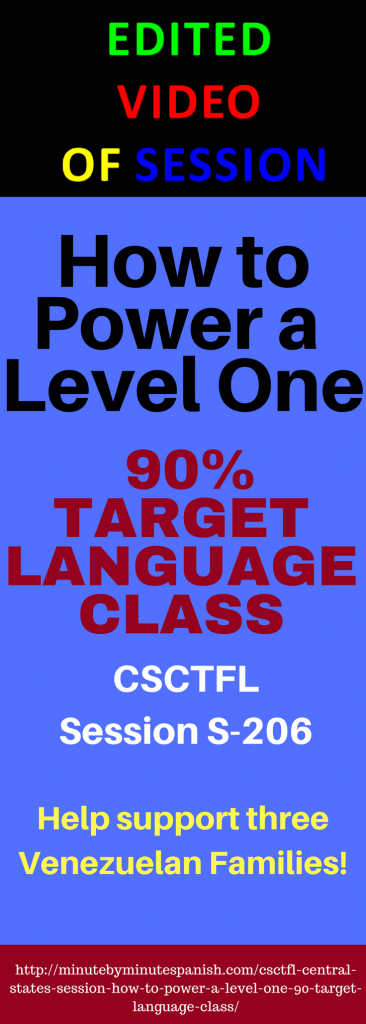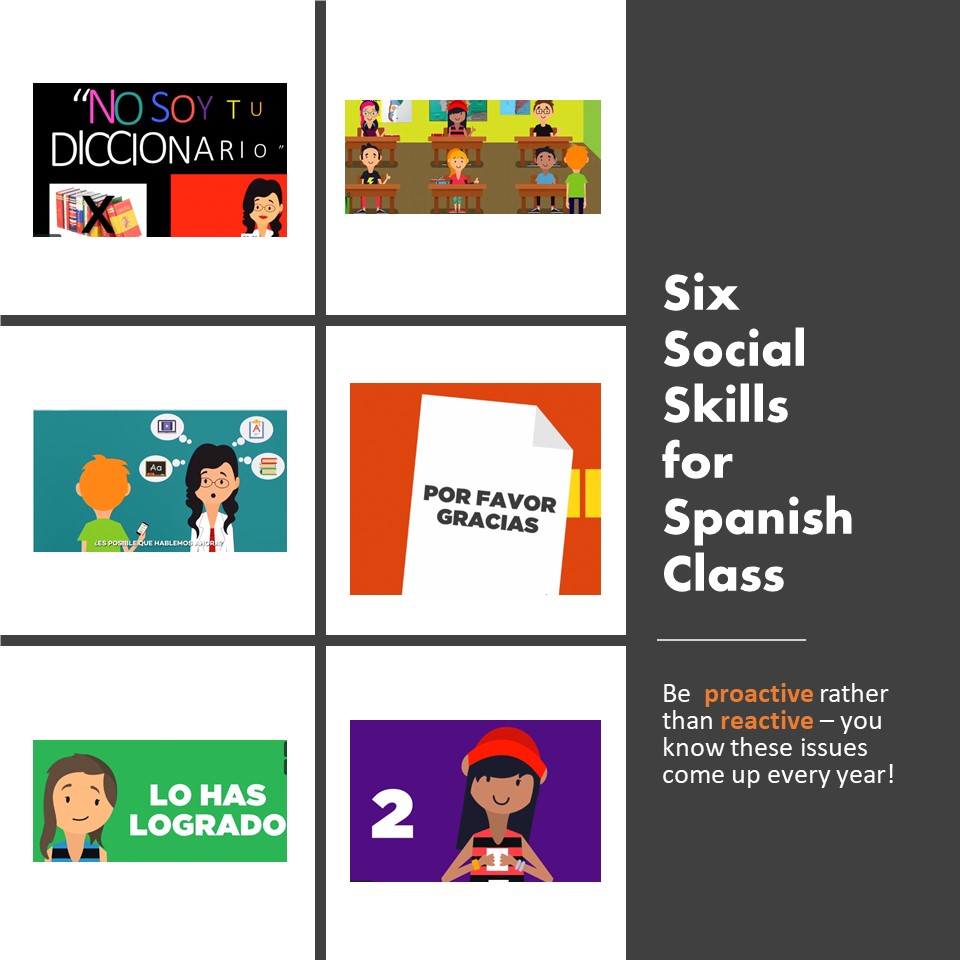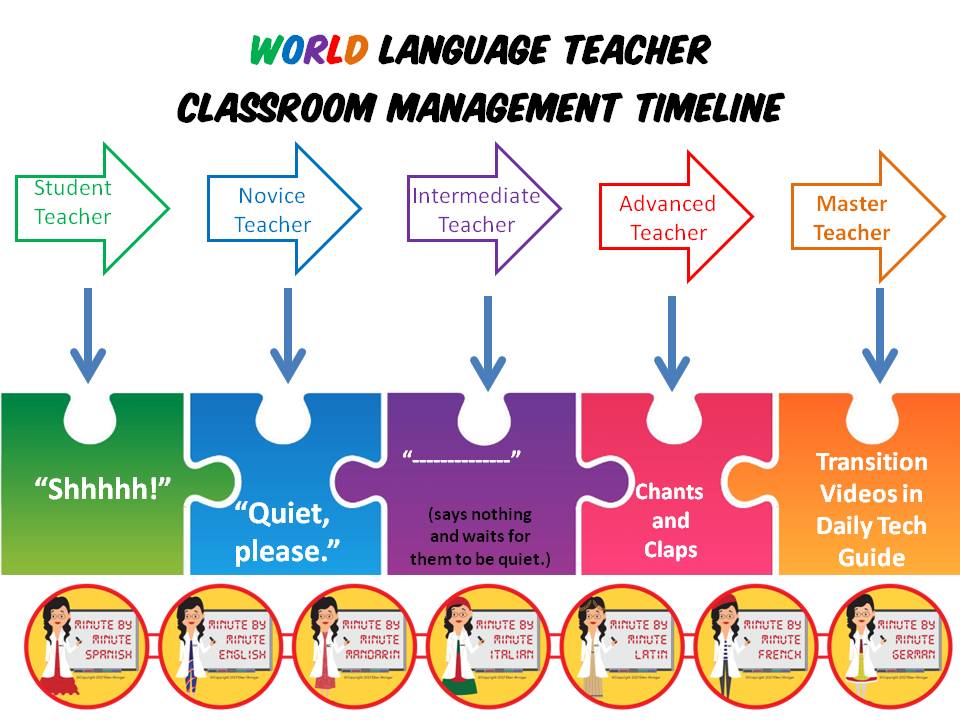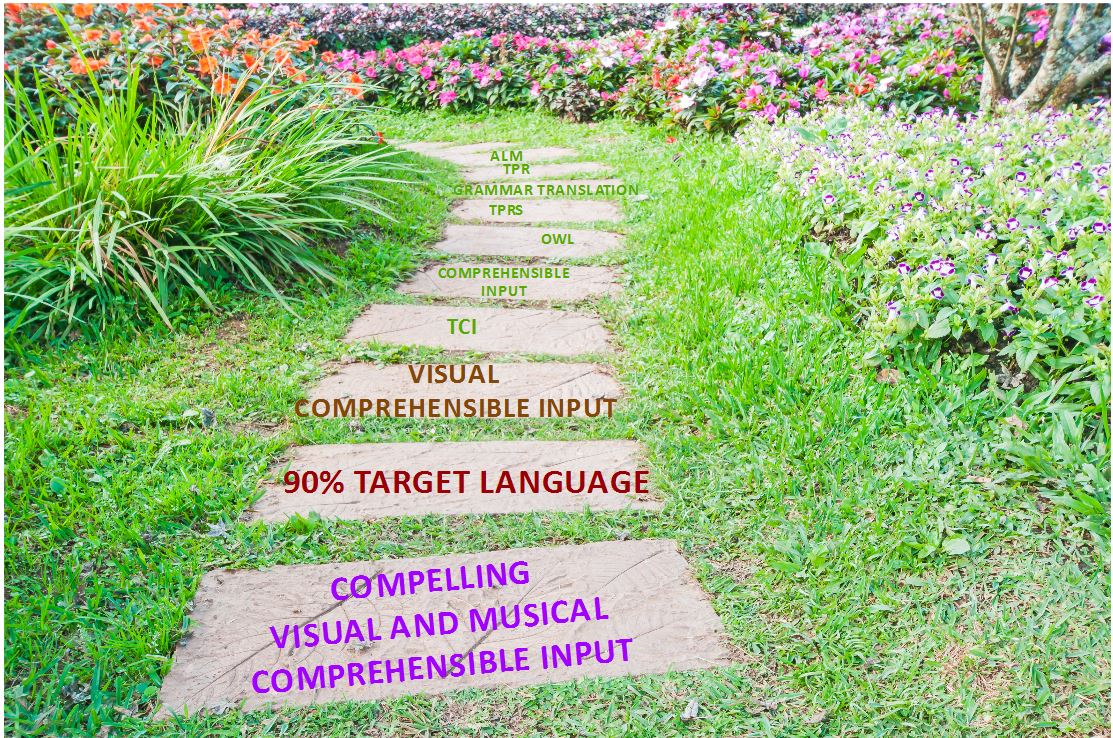
Stay on Task and in the target language with transition videos.
Spanish Lessons

Stay on Task and in the target language with transition videos.
Handout for central states 2018 Friday S-206



When I started teaching in the 80’s, teachers were expected to be caring adults providing boundaries and feedback about appropriate behavior.
In 2020, when responding to a student’s inappropriate behavior, I am contacted by parents about their concern that I don’t like their child. I fear that students are learning their social skills from social media; many are not making the correct leap from talking to Alexa to talking to their teacher.
After thirty plus years of teaching the same age group, I can predict certain topics that come up every year and rather than correct a student for being inappropriate, I proactively give direct instruction on social skills using catchy musical videos to everyone. Thus, when a student is interrupts, or treats me like a walking dictionary, the rest of the class breaks out into song and the correction is considered impersonal rather that a personal correction.
We, my Venezuelan friends and I, have created six musical videos sung in Spanish to demonstrate these skills. See the video below about the Venezuelans who make the songs and videos and how all net proceeds go to them as this is my charity work.
It includes offering to escort the new student to his or her next class, offering to eat lunch together, sharing recent classwork, and welcoming them to the class.
Many students write emails to teachers as if they were texting a friend. This social skill video reminds students to identify themselves, address the teacher by name and use querido, atentamente, por favor, gracias. The video reminds them that their future bosses may not know how capable they are because their poor manners.
This will save you from middle school teacher burnout! I share rooms and am rushing into set up my laptop and complete a variety of housekeeping tasks and it can take my last ounce of patience when a student just starts talking to me in a long-winded story. Now they know to first ask if now is a good time and if it isn’t I always circle back to them. This has made for much more pleasant relationships and a smooth start to class. It may very well help them to keep future jobs. Parents tell me they love it when I explain it to them at Open House and they also use it with me!
The best way to ensure that students get along in a class is to use random grouping cards and explain to them the importance of learning how to work with everyone. All of the directions are included along with the video. Be the adult in the class and set the expectation that they must work with anyone for a week at a time and they will. Let’s fight the growing tide of selected social media narrowing the variety of exposure that students have to different kinds of people. By the end of the year, substitute teachers and students will comment on how well the class gets along.
We must give our students direct instruction on how to congratulate one another in the target language.
Use this musical video, and ‘en hora buena’ and ‘felicitaciones’ will roll off their tongues at appropriate times.
Let’s further examine this issue of asking Spanish teachers to be a walking dictionary.
Students in our classes are accustomed to asking Alexa questions at home and getting immediate answers. When I first started teaching, we spent a couple of days using paper dictionaries and teaching them how to look up infinitives and other basic skills. Now we train them to use Word Reference while they may still very well be ‘Google Translating’ their homework.
I even had a parent send me a google translated e-mail – and she has never studied Spanish. She thought I would be so impressed! But I digress.
We train our students to ask three before me or use three before me or write their name on the board with the word they need help with in the hopes a classmate will help out.
But the best solution is to teach them the song “No soy tu diccionario” and when they forget and ask you how to say something the rest of the class breaks out into the song.
It works!
Every year students want to learn how to insult one another in Spanish. They will ask me how to say “stupid” in Spanish so that they can insult one another.
You do you with your teaching voice, but my response, said with the sweetest, most sincere drippy concern of a grandmother, “oh honey, I see why you feel that way about yourself but it would break my heart to have you talk about yourself that way, no I just can’t add to your negative self-talk – you are just too good!” This puts the kid in checkmate – can’t admit he/she wants to use it for others and the whole class is laughing about my thinking he/she wants to call himself/herself stupid when clearly the intention is to insult someone else.
All net proceeds help three Venezuelan families – meet them in this video as they open three boxes I sent to them.
If you want to read more about class structure and transition videos, read my blog here.
If your school won’t provide you with these tools, you may consider this:





I wish taxpayers who begrudge our summer break could see all of the June posts popping up on Facebook as World Language Teachers research and plan for the new school year.
Many posts ask how to make a level one class 100% comprehensible so that both teachers and students can stay in the target language.
I’ve always addressed this in pieces but it’s time to put it all three steps together as teachers recharge and envision the way they want their classes to run.
Incorporate these three steps and you will have your 90% Target Language class . . . and superior classroom management.
Create a slide for each activity and use a remote presentation device or remote mouse so you can click through the slides from any spot in the room,  say near the students who go off task most frequently. Click here to download the first day and see videos of the first week to give you an idea.
say near the students who go off task most frequently. Click here to download the first day and see videos of the first week to give you an idea.
My book describes it in more detail.
Other bundles are also Spanish Lessons here..
2. Use transition videos before each slide to keep the students on task and in the target language.
See them here. Spanish available here.
3. Use direct instruction to teach students 50 survival phrases set to music. Include the matching posters and desk reference sheet – focusing on the student – to – student slides so that they know how to talk to one another in the target language.
See them here. Available here.



Congratulations. Regardless of the actual number of years teaching, you are an advanced teacher if you use chants and claps for transitions to manage your classroom.
Are you ready to go to the next level?
Here are the three steps to follow to move from being an advanced classroom manager to a master classroom manager.
Three Steps:
1. Make a slide for each activity in today’s lesson — make it appealing and useful. (for more ideas, read The World Language Daily Tech Guide)
2. Insert one of my brief 50+ transition videos before the slide and train your students to watch the video in Spanish. Soon they are imitating the voice over or else singing the song. Do this every day and when you are observed by your administrators they will note your seamless transitions. You will notice that the students stay in the target language and that the expressions in the videos just fall from your students’ mouths appropriately in other scenarios! Even my level one students are spontaneously contributing these expressions at appropriate times!
3. Buy a remote presentation device or wireless mouse and click to the next slide from any part of the room so you can stand close to students who struggle to behave.
Here are the basic 21 videos for transitions:
More Transitions:
Click here for another thirty videos!



The defining moment when language teachers realize that comprehensible input is the key to students learning a language is a mixed blessing: they are excited with possibilities and overwhelmed with how to do it. This blog reflects the best practices for world language teachers in 2017 using technology to reach the LINKSTERS, also known as Generation Z, those born after 2000.
This blog is a response to a teacher who reached out to me on my TPT Q & A page and wrote:
So I am loving your slides! I have a few questions and I wanted to ask you. I see that your site speaks about TPRS and now VCI. Do you use both? Or do you now primarily use VCI?
Today’s TPRS is very different from what Blaine actually was using in his classroom.
I first learned about TPRS back around 199 something when Blaine Ray and Susi Gross started working together. I think we all had breakfast together in New Jersey during their second seminar together.
Back then, on that second day of the seminar, I was earnestly telling him that I couldn’t give up “my song of the week” and “my daily newspaper headline readings”  –
–  all wonderful additions to my classroom as we had just installed the internet in school. Susi was smiling and tilting her head as she taught the way I did, all the while Blaine insisted we drop everything and do his seven-step process. With Susi’s influence, it was whittled down to five steps, and many best practices were tucked under the TPRS umbrella.
all wonderful additions to my classroom as we had just installed the internet in school. Susi was smiling and tilting her head as she taught the way I did, all the while Blaine insisted we drop everything and do his seven-step process. With Susi’s influence, it was whittled down to five steps, and many best practices were tucked under the TPRS umbrella.  Susi also softened some of Blaine’s examples of dealing with non-compliant students, his insistence that he never prepped for class, rather played golf 20 minutes after the last bell rang, and his stories that crossed certain lines; Susi made TPRS become a more gentle and loving way of teaching. Together they became a dynamic teaching duo, attracting many great teachers. Their message to teachers to use more target language with the students and focus less on textbook activities resonated with many. They added wonderful teaching practices like
Susi also softened some of Blaine’s examples of dealing with non-compliant students, his insistence that he never prepped for class, rather played golf 20 minutes after the last bell rang, and his stories that crossed certain lines; Susi made TPRS become a more gentle and loving way of teaching. Together they became a dynamic teaching duo, attracting many great teachers. Their message to teachers to use more target language with the students and focus less on textbook activities resonated with many. They added wonderful teaching practices like  “embedded reading” and “movietalk” to the TPRS umbrella.
“embedded reading” and “movietalk” to the TPRS umbrella.  Susi started doing workshops on “the song of the week.” It became an energizing movement among World Language educators. It also became more fluid. Certain parts, like gesturing the vocabulary, became optional and not mandatory as committed teachers tried different things to test what worked best with their students, and reported back the results.
Susi started doing workshops on “the song of the week.” It became an energizing movement among World Language educators. It also became more fluid. Certain parts, like gesturing the vocabulary, became optional and not mandatory as committed teachers tried different things to test what worked best with their students, and reported back the results.
Some of the TPRS gurus stopped teaching and focused on giving seminars and creating books. In my opinion, while they represented good teaching, they stopped representing the latest teaching practices available with technology.
Those who stopped teaching never had to teach with high-stakes testing and with compliance with national goals. They never had to teach students who have no other alternatives because the electives have all been cut. They never taught students with cell phones fact checking everything they said. They haven’t taught 1:1 and some missed teaching with an interactive board. Teachers who had stopped teaching believed they knew about our new reality, but they never lived it. With technology today, we can easily create compelling opportunities for students to interact spontaneously, reducing the novelty of circling and storytelling from the 90’s.
Predictably, there was a split in the TPRS camp! It was somewhat hushed up, but it fell along many of the beliefs that divide our country: the definition of marriage. Groups split off and CI and TCI were two of them.
About this time, ACTFL started developing the idea of 90% Target Language teaching earlier than the traditional benchmark of the third year of the language.
Along the path to learning with 90% TL during the first year, students must engage with compelling, comprehensible input. Dr Krashen’s ideas about comprehensible input and not pushing for output gained more momentum.
A lively debate has grown as to the ‘best’ path to total comprehensible input. Probably 99% per cent of teachers in the classroom today support eclectic activities as stepping stones to create the right path for each individual teacher. But there are a vocal few who insist that only their way that matches their teaching voice is the universal path for all. Some appear to have plenty of time to bully and belittle people who choose a different path to comprehensible input. Hence, a lot of us don’t engage in theory debates, we use the latest technology and other tools to prepare lessons that bring remarkable results for our classroom management and for our students speaking in the target language.
While I can choose among many different kind of activities suggested by TPRS, CI, OWL, AIM, and TCI, my students have taught me that they need visual support for their comprehensible input.
I started offering a slide for every activity and then for transitions and the next thing I knew, the whole class was scripted with support and the Spanish One students and I were able to stay in the target language by using Visual Comprehensible Input.
I thought I was set until retirement when a funny thing happened. The class of ’95 wanted me to join FaceBook so that I could be up on all of their activities for the reunion. From there, I was able to connect with some of my friends from when I lived Venezuela. They are desperate for work and money. Next thing I know, I am paying them to sing my songs and to bring my storyboards to life in videos. Now all of my transitions are supported by videos and the number of slides needed to tell students what to do has been reduced to a 30 second clip showing them what to do.
I am astounded. On the second day of class, I showed the “Saquen la Tarea” transitional video, and as I walked around the room, the students each said “La tengo.”
We haven’t looked back. While I don’t know much about research, I believe that the focus on Dr. Krashen’s theory only goes so far. Once I introduce musical transition videos, the output gushes out of their mouths like nothing I have ever seen.
Sure they sing my Sr. Wooly songs with enthusiasm and asked to go to the bathroom, but that is just one of my 50 musical survival slides. The 35 transition videos with the announcer voice and the 10 transition videos with the songs and the 50 musical survival slides all have entered a different part of the brain, in my opinion. I think the next step, is CVMCI Compelling Visual and Musical Comprehensible Input.
So, Olgie, to answer your question, I use many activities also used by TPRS, CI, AIM, TCI and OWL teaching voices, but the latest development is CVMCI. No theory, no research, just my classroom experience. I’ll be sharing what I believe to be cutting edge ideas in Lansdale, PA on October 5th, in Boston, MA at ACTFL on Friday, November 18th, and at Central States in Chicago on Friday, March 10, 2017.
These videos support some very desperate families in Venezuela. Read my blog about them and what you can do to help.



| Cookie | Duration | Description |
|---|---|---|
| cookielawinfo-checkbox-analytics | 11 months | This cookie is set by GDPR Cookie Consent plugin. The cookie is used to store the user consent for the cookies in the category "Analytics". |
| cookielawinfo-checkbox-functional | 11 months | The cookie is set by GDPR cookie consent to record the user consent for the cookies in the category "Functional". |
| cookielawinfo-checkbox-necessary | 11 months | This cookie is set by GDPR Cookie Consent plugin. The cookies is used to store the user consent for the cookies in the category "Necessary". |
| cookielawinfo-checkbox-others | 11 months | This cookie is set by GDPR Cookie Consent plugin. The cookie is used to store the user consent for the cookies in the category "Other. |
| cookielawinfo-checkbox-performance | 11 months | This cookie is set by GDPR Cookie Consent plugin. The cookie is used to store the user consent for the cookies in the category "Performance". |
| viewed_cookie_policy | 11 months | The cookie is set by the GDPR Cookie Consent plugin and is used to store whether or not user has consented to the use of cookies. It does not store any personal data. |